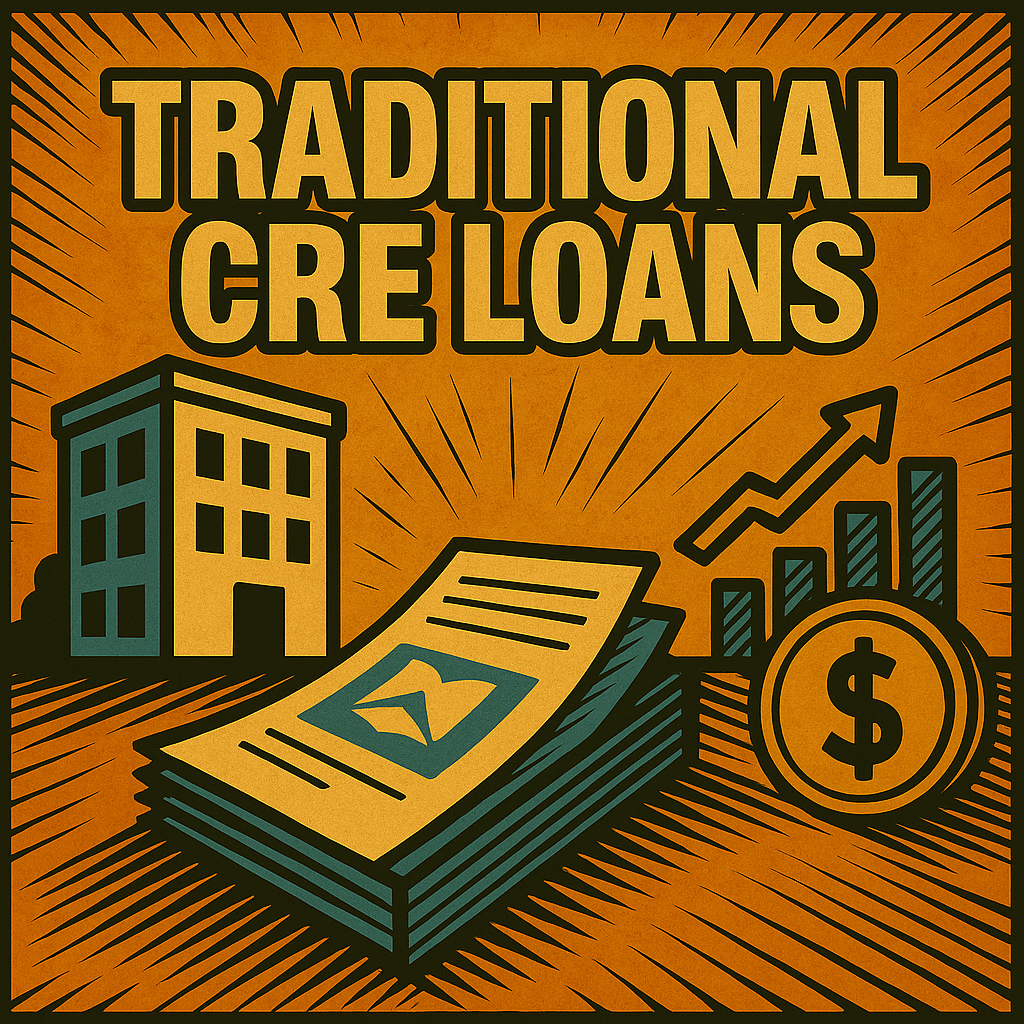Traditional Commercial Real Estate (CRE) Loans
“Steady, standard, and still the most common.”

Not every real estate deal needs a 1031 exchange or an exotic structure. Often, it’s just about borrowing to buy or refinance a building — a standard loan backed by real property. These are traditional CRE loans — foundational tools in the real estate finance world. Whether you’re acquiring an office building, a strip center, or a warehouse.
A commercial real estate loan is financing secured by property that’s used for business (or investment) purposes. Unlike residential loans, these are underwritten based on the property’s income (or business operating income), the borrower’s financials, and the deal structure — not just personal credit.
Typical Loan Terms & Structure
| Component | Typical Range or Setup |
|---|---|
| Loan Term | 5 to 10 years |
| Amortization | 20–30 years (often longer than the term) |
| Interest Rate | Fixed or floating (SOFR + spread, or internal index) |
| Balloon Payment | Often due at maturity if loan is not fully amortized |
| Loan-to-Value (LTV) | 65% – 80%, depending on property and borrower strength |
| Debt Service Coverage Ratio (DSCR) | Minimum typically 1.20x |
| Recourse | Often required for smaller borrowers or riskier deals |
| Fees | 0.5% – 1.5% origination; third-party closing costs |
Common Use Cases
Purchasing office, retail, industrial, or warehouse property
Refinancing existing commercial mortgages
Acquiring multi-family buildings (5+ units)
Buying owner-occupied real estate for a business
Renovating or repositioning a stabilized asset
Example Deal Structure
Property: Small industrial building
Loan Amount: $1.8M
Purchase Price: $2.4M (75% LTV)
Term: 7 years, 25-year amortization
Interest Rate: 7.25% fixed
Balloon Due: ~$1.5M at maturity unless refinanced
What Lenders Look For
- Borrower financials (net worth, liquidity, operating cash flow, real estate experience)
Market fundamentals (location, demand, comps)
- Property performance (NOI, occupancy, tenant mix)
Exit strategy (refinance, sale, long-term hold)
Legal and environmental status (clear title, clean Phase I)
Who Offers These Loans?
| Lender Type | Typical Focus |
|---|---|
| Banks & Credit Unions | Local/regional deals, owner-occupied CRE |
| Life Insurance Cos. | Core, stabilized assets with low leverage |
| Private Debt Funds | Shorter terms, more flexible underwriting |
| SBA/504 Programs | For owner-occupied real estate with favorable terms |
🏢 Example: Office Building
Owner-Occupied
| Property Type | Small Office Building (Owner-Occupied) |
|---|---|
| Purchase Price | $1,500,000 |
| Loan Amount | $1,125,000 (75% LTV) |
| Down Payment | $375,000 (25%) |
| Loan Term | 10 years |
| Amortization | 25 years |
| Interest Rate | 7.10% fixed |
| DSCR Requirement | 1.25x |
| Recourse | Full personal guarantee from business owner |
| Balloon | Due at end of term unless refinanced |
🏭 Example: Industrial Warehouse
(Investor-Owned)
| Property Type | Light Industrial / Warehouse |
|---|---|
| Purchase Price | $2,200,000 |
| Loan Amount | $1,540,000 (70% LTV) |
| Down Payment | $660,000 (30%) |
| Loan Term | 7 years |
| Amortization | 25 years |
| Interest Rate | SOFR + 3.00% (floating) |
| DSCR Requirement | 1.20x |
| Recourse | Limited (carve-outs only) |
| Balloon | ~$1.3M due at maturity |

Final Thoughts
Traditional commercial real estate loans are the workhorse of CRE financing. They’re flexible, widely available, and adaptable across asset types — from local strip malls to stabilized apartment complexes. If your deal is straightforward and your financials are solid, this is often the fastest path to owning or refinancing property. Get the fundamentals right — DSCR, LTV, guarantees — and you’re in business.

